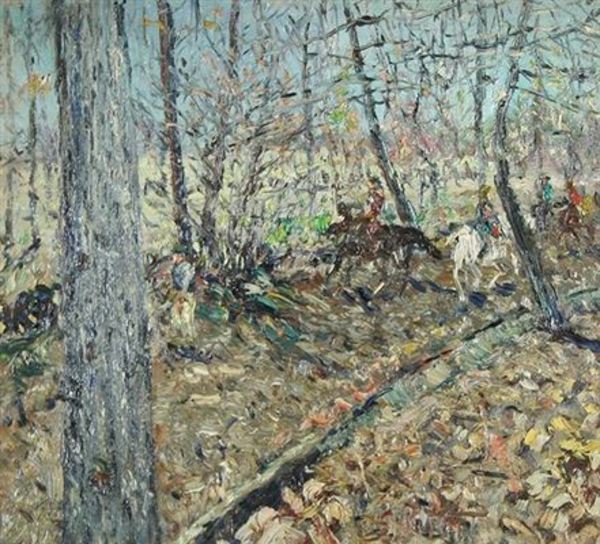-
Artist: Samuel Rothbort (American (born in Russia), 1882-1971)
“Samuel Rothbort was born November 1882 in Volkovisk, White Russia. His father was a scholar and his mother was the breadwinner, operating a flour and grain stand. Samuel worked during his youth as a Cantor and traveled to various towns and villages gaining many impressions of Jewish life. Poverty, as well as the political unrest led him to becoming a Bundist (Jewish Socialist Movement) for a very short time. The political unrest of the times led to his immigration to America in 1904” (1 askart).
“He immigrated to New York in 1904 and took a variety of unskilled jobs, including night watchman on a construction site. The master builder on the site noticed Rothbort drawing on unfinished plaster and decided he was too talented to be a watchman. As a result, Rothbort became a decorator, creating designs in paint and plaster for the homes of wealthy Manhattanites” (2).
“Samuel Rothbort was self taught, painting every subject in his own impressionistic style. His artistic range was broad and he never stopped creating. He was fascinated with nature and his works are filled with his delightful perceptions of his surroundings. Rothbort worked in oil, watercolor, and pen & ink. In the years of the depression there was little money, Rothbort could not afford paint or canvas. It was there that he began carving wood and stone using found materials like driftwood, rails, and old fence posts. At that time the press called it ‘Fencepost art’” (3).
“In 1909, he married Rose Kravitz. It also marked the beginning of his career as a serious artist. He stated that on the day before his wedding, a still life he had painted put him on the path he was to follow for the rest of his life. He and his wife moved to a farm raising chickens in the Catskills, where he continued to paint. They did not succeed financially and returned to Flatbush, Brooklyn, which, became their permanent home” (1).
“Samuel Rothbort was a member of several professional associations of artists, including The Brooklyn Society of Artists, The Society of Independent Artists, and The Salons of America. In 1919, Rothbort was represented in a group show presented by The Brooklyn Society of Artists. It was here that he met critic, teacher, and publicist, Hamilton Easter Field ( 1873 - 1922 ). Field was a leading influence on the development of modernism in the United States, although he remained conservative in his own creative expression. He operated a school and gallery in his home in the Columbia Heights section of Brooklyn and a summer school that he established at Perkins Cove in Ogunquit, Maine. Field characterized Rothbort as exceptionally talented and would serve as Rothbort's patron until his premature death in 1922. In 1952, Rothbort wrote a book on his sculpture, entitled " Out of Wood & Stone " , [sic] which he dedicated to Hamilton Easter Field” (3).
“He was also represented by Harriet Semegram from 1955 until his death in 1971” (1).
“Samuel Rothbort died in 1971, leaving behind an impressive collection of paintings and sculpture. His subjects contain flowers, fields, landscapes and other scenes plus over a hundred self-portraits” (3).
Reference:
1.
Askart staff. Samuel Rothbort [internet]. [cited 2015 July 3]. Available from: http://www.askart.com/artist_bio/Samuel_Rothbort/24317/Samuel_Rothbort.aspx
2.
Smithsonian American Art Museum Staff. Samuel Rothbort [internet]. [cited 2015 July 3]. Available from: http://americanart.si.edu/collections/search/artist/?id=7070
3.
Alexander Gallery Staff. Samuel Rothbort [internet]. [cited 2015 July 3]. Available from: http://alexandergallery.biz/artist.php?id=authors_details&author_id=65
